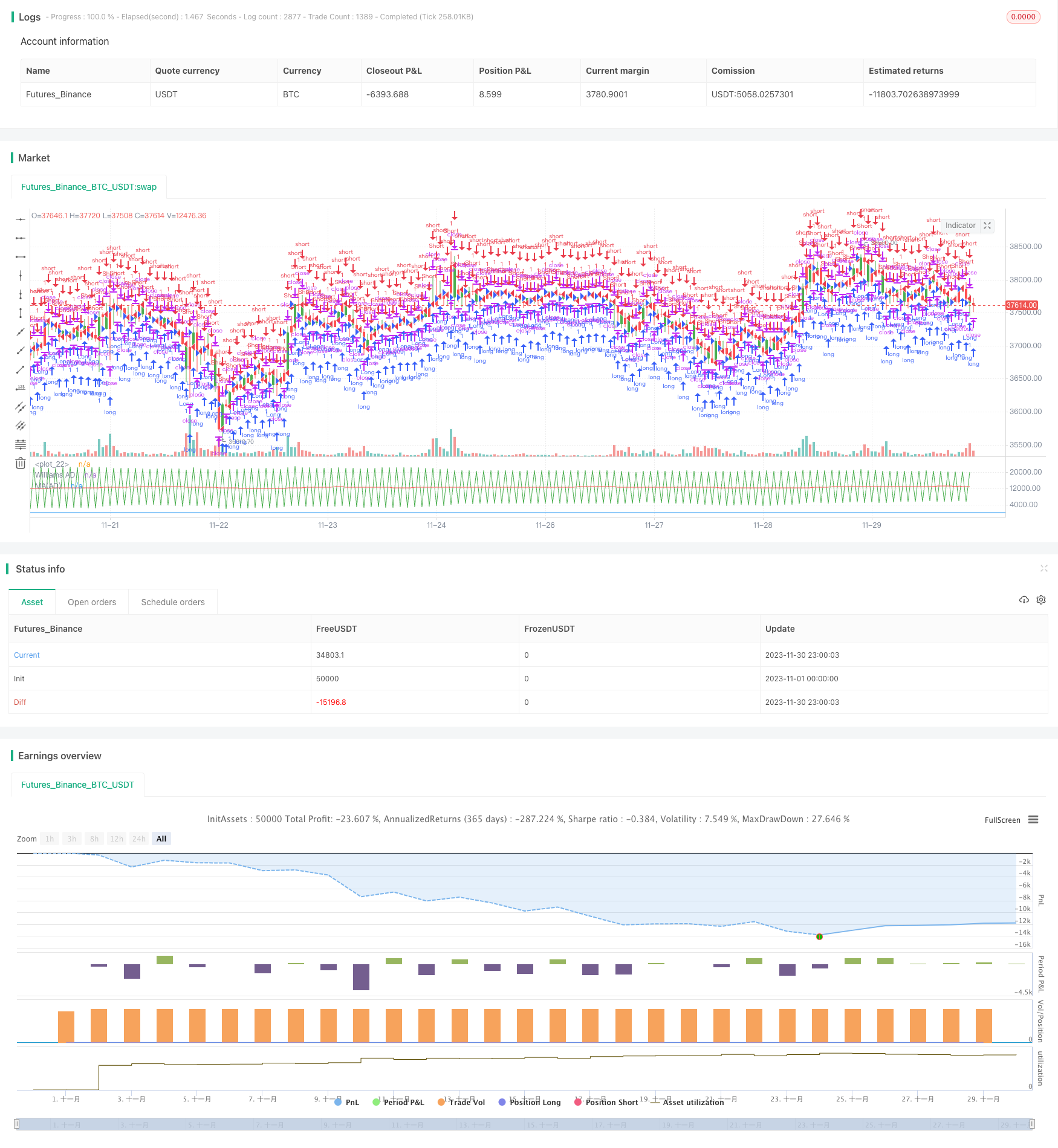
该策略的主要思想是利用Williams商业区买卖压力指标判断市场的累积与分配阶段,以发现价格和Williams指标之间的背离,从而产生交易信号。当安全资产创下新高但Williams指标没有创下新高时,代表博弈参与者分配,应卖出;当安全资产创下新低但Williams指标没有创下新低时,代表博弈参与者累积,应买入。
策略原理详述如下:
该策略基于Williams商业区买卖压力指标,该指标反映市场的买卖压力,判断市场被买方或卖方所控制。Williams指标通过对收盘价、最高价和最低价的计算,判断价格的累积与分配。当价格创新高但Williams指标没有创新高,代表分配,应卖出;当价格创新低但Williams指标没有创新低,代表累积,应买入。
本策略运用Williams指标判断市场的累积和分配,以发现价格背离并产生交易信号。同时,利用移动平均线来平滑Williams指标,避免出现错误信号。当Williams指标高于其移动平均线时为累积阶段;低于移动平均线时为分配阶段。在发现背离时,若为长仓则在分配阶段卖出,在累积阶段买入;若为短仓则相反。
该策略主要优势有:
能准确判断市场的买卖压力,捕捉价格趋势的转折点。
运用移动平均线来平滑指标曲线,避免产生错误信号。
规则清晰明确,易于理解与实施。
可灵活调整参数,适用于不同市场环境。
主要风险及解决方法如下:
Williams指标可能产生错误信号,移动平均线可在一定程度上减轻这一问题。
若参数设置不当,可能错过价格转折或产生虚假信号。应调整参数使其适应不同周期。
须关注突发事件对价格的影响,必要时暂停交易计划。
该策略主要可优化的方向:
测试更多参数组合,寻找最佳参数。
增加其他技术指标进行组合,提高信号准确性。
增加止损策略,降低单笔损失。
优化入场时机,在趋势更加明确后进入。
总的来说,本策略利用Williams商业区买卖压力指标判断市场博弈参与者的意愿,再结合移动平均线发现价格背离,从而产生交易信号。该策略易于理解实施,可通过调整参数适用于不同市场,也可进行多方面优化,值得深入研究与运用。
/*backtest
start: 2023-11-01 00:00:00
end: 2023-11-30 23:59:59
period: 1h
basePeriod: 15m
exchanges: [{"eid":"Futures_Binance","currency":"BTC_USDT"}]
*/
//@version=2
////////////////////////////////////////////////////////////
// Copyright by HPotter v1.0 23/01/2018
// Accumulation is a term used to describe a market controlled by buyers;
// whereas distribution is defined by a market controlled by sellers.
// Williams recommends trading this indicator based on divergences:
//
// Distribution of the security is indicated when the security is making
// a new high and the A/D indicator is failing to make a new high. Sell.
//
// Accumulation of the security is indicated when the security is making
// a new low and the A/D indicator is failing to make a new low. Buy.
//
//You can change long to short in the Input Settings
//WARNING:
//- For purpose educate only
//- This script to change bars colors.
////////////////////////////////////////////////////////////
strategy(title="Smoothened Williams Accumulation/Distribution (Williams AD)", shorttitle="Williams AD")
Length = input(14, step = 1)
reverse = input(false, title="Trade reverse")
hline(0, color=blue, linestyle=line)
xPrice = close
xWAD = iff(close > nz(close[1], 0), nz(xWAD[1],0) + close - low[1],
iff(close < nz(close[1],0), nz(xWAD[1],0) + close - high[1],0))
xWADMA = sma(xWAD, Length)
pos = iff(xWAD > xWADMA, 1,
iff(xWAD < xWADMA, -1, nz(pos[1], 0)))
possig = iff(reverse and pos == 1, -1,
iff(reverse and pos == -1, 1, pos))
if (possig == 1)
strategy.entry("Long", strategy.long)
if (possig == -1)
strategy.entry("Short", strategy.short)
barcolor(possig == -1 ? red: possig == 1 ? green : blue )
plot(xWAD, color=green, title="Williams AD")
plot(xWADMA, color=red, title="MA(AD)")